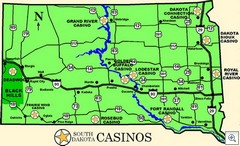 The voters of South Dakota made the state the nation’s third commercial casino jurisdiction at the ballot box in November 1988. The voters in effect amended the state constitution to permit limited stakes gambling, but only in the town of Deadwood. In 1989 the legislature passed an enabling act, and the voters of Deadwood ratified the decision to have casinos in their town. Several casinos opened in November 1989, and there are now over sixty casinos in Deadwood. The ostensible purpose of casino gaming was to generate revenues for tourist promotion and for historical preservation projects in Deadwood. Wild Bill Hickok had been shot in the back while playing poker in Deadwood in 1876, but the town was a decaying relic from that time. The town’s main block of buildings had burned in the mid-1980s.
The voters of South Dakota made the state the nation’s third commercial casino jurisdiction at the ballot box in November 1988. The voters in effect amended the state constitution to permit limited stakes gambling, but only in the town of Deadwood. In 1989 the legislature passed an enabling act, and the voters of Deadwood ratified the decision to have casinos in their town. Several casinos opened in November 1989, and there are now over sixty casinos in Deadwood. The ostensible purpose of casino gaming was to generate revenues for tourist promotion and for historical preservation projects in Deadwood. Wild Bill Hickok had been shot in the back while playing poker in Deadwood in 1876, but the town was a decaying relic from that time. The town’s main block of buildings had burned in the mid-1980s.
Prior to casino gaming, the state had permitted dog- and horse-race wagering. The state had instituted a lottery in 1987, and in 1989 the lottery had also began operation of video lottery terminals in age-restricted locations. Each location was allowed twenty machines that awarded, on average, 80 percent of the money played as prizes given back to the players. In the 1990s, nine Native American casinos compacted with the state to operate facilities. The casinos are located at Sisseton, Hankinson, Watertown, Wagner, Lower Brule, Mobridge, Fort Thompson, Pine Ridge, and Flandreau.
The commercial casinos in Deadwood were originally allowed to have thirty games (machines or tables), but as facilities were built together, the state changed the limitation to ninety games each for a single retail location. In addition to machines, which guaranteed prizes equaling 90% of the money played, the only games permitted were blackjack and poker. Bets were limited to five dollars per play. In the poker games the casino could rake-off as much as 10% of the money wagered. The casinos pay 8% of their winnings to the state in taxes; of this, 40% goes to tourist promotions, 10% to the local government, and 50 percent to the state for regulatory purposes. If regulatory costs fall below this amount, the remaining money is dedicated to historical preservation projects.
In 1989, the lottery began using video machines located in restaurants and bars around the state. In 2000, antigambling interests made attempts to stop the lottery machines, but according to the New York Times of 9 November 2000 (B-10), the voters decided to keep them.
|
|